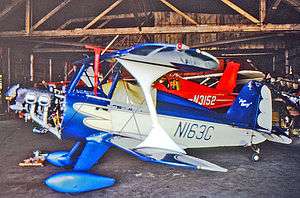Stolp Starduster
The Stolp-Adams SA-100 Starduster is a U.S. single seat sport biplane designed to be built from plans supplied by Aircraft Spruce & Specialty Co. Though the first flight was in 1957, Stardusters continue to be built and flown.[2]
| Starduster | |
|---|---|
 | |
| Stolp-Adams Starduster, amateur-built in 1966, at Long Beach Airport, California, in 1971 | |
| Role | Single seat sport aircraft |
| National origin | United States |
| Manufacturer | Stolp Aircraft Aircraft Spruce & Specialty Co. |
| Designer | Louis A. Stolp and George M. Adams |
| First flight | November 1957 |
| Status | Plans available (2012) |
| Unit cost |
approximately $3600 to build in 1971[1] |
| Variants | Stolp Starduster Too |
Design and development
The SA-100 Starduster was designed by Louis A. Stolp and George M. Adams as a light sports aircraft for homebuilding from plans. It is a single bay biplane with fabric covered, wooden framed staggered wings, each pair braced by a single, wide chord interplane strut aided by bracing wires. A total of eight centre section struts join the upper wing to the fuselage, basically two pairs in N-form but with the forward strut doubled. The lower wing is unswept and has 1.5° of dihedral; the upper wing has 6° of sweep on its leading edge, no dihedral and a greater span. There are ailerons on the lower wings only, but no flaps.[3]
The fuselage and tail unit have a fabric covered steel tube structure, with the open cockpit positioned just behind the swept upper wing trailing edge which has a rounded cut-out for upward visibility. There is a long and prominent faired headrest behind the cockpit, on top of the curved upper fuselage surface. The Starduster has a conventional tail unit, with a wire braced tailplane and straight tapered, round topped fin and rudder, the latter extending to the keel between split elevators. Both rudder and elevators are horn balanced.[3]
The Starduster has a recommended power range of 125 to 160 hp (93 to 119 kW) and is usually powered by a four-cylinder, horizontally opposed, 125 hp (93 kW) Lycoming O-290-D-1,[3] though more powerful engines of up to 200 hp (150 kW) have been fitted.[4] It has a conventional tailwheel undercarriage. The mainwheels are mounted on V-struts hinged from the lower fuselage longeron, with rubber shock absorbers on diagonal extension struts between wheel and a short, central, under fuselage V-form mounting bracket. The main legs are often partially or completely faired and the wheels enclosed in spats.[2][3]
Operational history
Starduster plans remain available more than 50 years after the first flight and homebuilding building continues.[5] A Starduster register[6] currently shows 27 SA-100 Stardusters and 3 SA-101 Super Stardusters built and building. The FAA register shows 64 SA-100s and 1 SA-101, though not all are assigned and some further Stardusters appear without a type number.[7]
Variants
- SA-100 Starduster
- Original version, designed for non-aerobatic flight.[8]
- SA-101 Stolp Super Starduster
- Larger and more powerful — uses the longer wings of the CA300 Starduster Too, which have a symmetric M6 airfoil and no dihedral, together with a 180 hp (134 kW) Lycoming I0-360-A1A engine to produce a maximum speed of over 170 mph (275 km/h).[9]
Specifications (SA-100)
Data from Jane's All the World's Aircraft 1966/7, p.331,[3] Aerofiles[10]
General characteristics
- Capacity: 1
- Length: 16 ft 6 in (5.03 m)
- Upper wingspan: 19 ft 0 in (5.79 m)
- Lower wingspan: 18 ft 0 in (5.49 m)
- Height: 6 ft 0 in (1.83 m)
- Wing area: 110.0 sq ft (10.22 m2)
- Aspect ratio: 6.33
- Airfoil: NACA 4412
- Empty weight: 700 lb (318 kg)
- Max takeoff weight: 1,080 lb (490 kg)
- Fuel capacity: 20 Imp gal (24 US gal, 91 L)
- Powerplant: 1 × Lycoming O-290-D-1 4-cylinder horizontally opposed air cooled, 125 hp (93 kW)
- Propellers: 2-bladed Sensenich M74DM61 fixed pitch
Performance
- Maximum speed: 148 mph (238 km/h, 129 kn)
- Cruise speed: 130 mph (210 km/h, 110 kn)
- Stall speed: 55 mph (89 km/h, 48 kn)
- Range: 400 mi (640 km, 350 nmi)
See also
Aircraft of comparable role, configuration and era
References
| Wikimedia Commons has media related to Stolp Starduster. |
- Leo J. Kohn (Winter 1971). "The true cost of building your own plane". Air Trails: 63.
- Bayerl, Robby; Martin Berkemeier; et al: World Directory of Leisure Aviation 2011–12, page 121. WDLA UK, Lancaster UK, 2011. ISSN 1368-485X
- Taylor, John W R (1966). Jane's All the World's Aircraft 1966–67. London: Sampson Low, Marston & Co. Ltd.
- "Starduster One SA100". Retrieved 2011-05-12.
- "Kits – Starduster". Retrieved 2011-05-12.
- "Starduster registry". Retrieved 2011-05-12.
- "FAA register". Retrieved 2011-05-12.
- Tacke, Willi; Marino Boric; et al: World Directory of Light Aviation 2015–16, page 128. Flying Pages Europe SARL, 2015. ISSN 1368-485X
- "SA101 Super Starduster". Retrieved 2011-05-12.
- "Aerofiles-Stolp". Retrieved 2011-05-11.